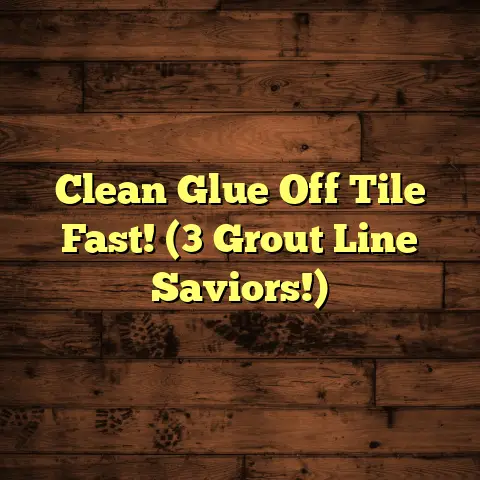Wood Effect Tiles: Durable? (5 Install Tips!)
Speaking of trends, wood effect tiles are exploding in popularity here! With our damp climate and love for the outdoors, folks are looking for that natural wood look without the maintenance headaches.
But the big question I keep hearing is: Are wood effect tiles really durable enough for our PNW lifestyle?
Think constant drizzle, muddy boots, and maybe even the occasional curious bear paw (hey, it happens!).
Let’s dive deep and find out, plus I’ll share 5 pro install tips to ensure your wood-look floor lasts for years to come.
Section 1: Understanding Wood Effect Tiles
So, what exactly are wood effect tiles?
Simply put, they’re tiles designed to mimic the appearance of real wood. They come in various materials, but the most common are ceramic and porcelain.
What’s the difference?
Ceramic is generally more porous and less dense, making it suitable for lighter-duty applications.
Porcelain, on the other hand, is fired at higher temperatures, resulting in a denser, more durable tile that’s perfect for high-traffic areas and wet environments.
The magic happens in the manufacturing process. High-definition printing technology allows manufacturers to create incredibly realistic wood grain patterns, textures, and even knots.
Think of it like a super-detailed photograph transferred onto a tile.
You can find wood effect tiles in a mind-boggling array of styles. From rustic reclaimed wood looks to sleek, modern designs, and everything in between.
Colors range from light, airy beiges to deep, rich browns, and you can even find tiles that mimic exotic wood species. The possibilities are endless!
Section 2: The Durability Debate
Alright, let’s get to the heart of the matter: durability. How do wood effect tiles stack up against traditional hardwood?
In many ways, they outperform hardwood, especially in our damp climate.
Here’s a breakdown:
- Water Resistance: Wood effect tiles are virtually waterproof (especially porcelain). Unlike hardwood, they won’t warp, swell, or stain when exposed to moisture. Big win for PNW homes!
- Scratch Resistance: These tiles are incredibly scratch-resistant. They can handle kids, pets, and heavy foot traffic without showing wear and tear. Try dragging a chair across a hardwood floor and then across a porcelain tile – you’ll see the difference.
- Wear Resistance: Wood effect tiles are incredibly durable and can last for decades with proper care. They don’t require refinishing like hardwood, saving you time and money in the long run.
| Feature | Wood Effect Tile (Porcelain) | Hardwood |
|---|---|---|
| Water Resistance | Excellent | Poor |
| Scratch Resistance | Excellent | Fair to Good |
| Wear Resistance | Excellent | Good |
| Maintenance | Low | Moderate to High |
Now, I know what you’re thinking: “Okay, John, but what about the feel?”
True, wood effect tiles don’t have the same warm, soft feel as real wood underfoot. But advancements in texture and underfloor heating can help bridge that gap.
I’ve installed wood effect tiles in countless kitchens, bathrooms, and entryways where hardwood simply wouldn’t be practical.
Think mudrooms where wet boots are a daily occurrence, or bathrooms where splashes are inevitable. These are the places where wood effect tiles truly shine.
According to a recent report by the Tile Council of North America (TCNA), porcelain tile has a lifespan of 50+ years with proper installation and maintenance. That’s a long-term investment!
Section 3: Benefits of Wood Effect Tiles
Let’s recap the awesome benefits of choosing wood effect tiles, especially for us PNW folks:
- Cost-Effectiveness: While the initial cost might be similar to hardwood, the long-term savings on maintenance and repairs make wood effect tiles a smart investment.
- Low Maintenance: Say goodbye to sanding, sealing, and refinishing! Wood effect tiles are incredibly easy to clean – just sweep, mop, and you’re done.
- Versatility in Design: As I mentioned earlier, the design options are endless. You can create any look you want, from rustic farmhouse to modern minimalist.
- Eco-Friendliness: Many wood effect tiles are made from recycled materials and are VOC-free, making them a more sustainable choice than some hardwood options.
- Perfect for Radiant Heating: Wood effect tiles are excellent conductors of heat, making them ideal for use with radiant floor heating systems. Talk about cozy feet on those chilly PNW mornings!
These benefits resonate strongly with homeowners in our region. We value durability, low maintenance, and a connection to nature. Wood effect tiles deliver on all fronts.
Section 4: Installation Tips for Wood Effect Tiles
Okay, you’re convinced! Wood effect tiles are the way to go. But how do you ensure a successful installation?
Here are my top 5 tips, learned from years of experience:
Tip 1: Preparing the Subfloor
This is the most crucial step. A level, stable subfloor is essential for preventing cracks, unevenness, and other problems down the road.
- Assess the Subfloor: Use a long level (at least 6 feet) to check for any dips, humps, or unevenness. Any variations greater than 1/8 inch over 6 feet need to be addressed.
- Concrete Subfloors: Fill any cracks or holes with a concrete patching compound. Grind down any high spots. For larger imperfections, consider using a self-leveling underlayment.
- Plywood Subfloors: Ensure the plywood is at least 3/4 inch thick and securely fastened to the joists. Replace any damaged or warped sections. You may also need to add a layer of cement backer board for added stability.
I can’t stress this enough: don’t skip this step! A poorly prepared subfloor will haunt you later.
Tip 2: Choosing the Right Adhesive
Not all adhesives are created equal. You need to choose one that’s specifically designed for tile and compatible with your subfloor material.
- Thin-Set Mortar: This is the most common type of adhesive for tile installation. Choose a modified thin-set mortar that’s suitable for porcelain or ceramic tile, depending on your tile type.
- Epoxy Mortar: For demanding environments like commercial kitchens or areas with heavy moisture exposure, epoxy mortar provides superior bond strength and chemical resistance.
- Consider the Tile Size: Larger tiles require a thicker bed of mortar to ensure proper support and prevent lippage (uneven tile edges).
Always follow the manufacturer’s instructions for mixing and applying the adhesive.
Tip 3: Acclimating the Tiles
Just like hardwood, wood effect tiles need to acclimate to the room’s temperature and humidity before installation.
- How to Acclimate: Stack the tiles loosely in the room where they will be installed for at least 24-48 hours. This allows them to adjust to the environment and minimizes the risk of expansion or contraction after installation.
- Why It Matters: Acclimation prevents warping, cracking, and adhesive failure. It’s a simple step that can save you a lot of headaches.
I’ve seen too many installations fail because this step was overlooked. Don’t make the same mistake!
Tip 4: Layout Planning
Planning your tile layout is crucial for achieving a visually appealing and functional floor.
- Find the Center: Start by finding the center of the room and working outwards. This ensures that the tiles are evenly distributed and that you don’t end up with small, awkward cuts along the edges.
- Consider Natural Light: Pay attention to the direction of natural light and how it will affect the appearance of the tiles. Align the wood grain pattern to enhance the natural light and create a sense of flow.
- Stagger the Joints: Staggering the joints (the lines where the tiles meet) creates a more natural and visually appealing look. A 1/3 or 1/2 offset is a common choice.
- Dry Lay: Before you start applying adhesive, lay out a few rows of tiles to visualize the layout and make any necessary adjustments.
A well-planned layout can make a huge difference in the overall look and feel of your floor.
Tip 5: Grouting and Finishing Touches
Grouting is the final step that ties everything together and protects your tile floor from moisture and dirt.
- Choose the Right Grout: Select a grout color that complements your tile and your overall design scheme. Consider using an epoxy grout for added stain resistance and durability.
- Apply the Grout: Use a grout float to press the grout into the joints, making sure to fill them completely.
- Clean Up: Wipe away excess grout with a damp sponge, being careful not to remove too much grout from the joints.
- Seal the Grout: Once the grout is dry, apply a grout sealer to protect it from stains and moisture.
- Maintain Your Floor: Regularly sweep or vacuum your tile floor to remove dirt and debris. Mop with a mild detergent and water as needed.
Proper grouting and sealing will extend the life of your tile floor and keep it looking its best for years to come.
Section 5: Real-Life Applications and Case Studies
I’ve seen wood effect tiles transform homes all over the Pacific Northwest. Here are a few examples:
- The Johnson Family’s Kitchen: They replaced their worn-out linoleum with wood effect porcelain tiles in a light, natural wood tone. The result was a bright, airy kitchen that’s easy to clean and perfect for their busy family.
- The Smith’s Mudroom: They installed dark brown wood effect tiles in their mudroom to create a durable and stylish entryway that can withstand the PNW’s rainy weather.
- The Jones’ Bathroom: They used wood effect tiles on the floor and walls of their bathroom to create a spa-like retreat with a natural, earthy feel.
I recently spoke with Sarah, a homeowner in Seattle, who installed wood effect tiles in her basement.
“We were worried about moisture in the basement, so hardwood was out of the question,” she told me. “The wood effect tiles look amazing, and we don’t have to worry about water damage. It’s the perfect solution!”
Another trend I’m seeing is the use of larger format wood effect tiles. These tiles create a more seamless look and can make a room feel larger.
Conclusion
So, are wood effect tiles durable? Absolutely! Especially when installed correctly and maintained properly.
They’re a fantastic option for homeowners in the Pacific Northwest who want the beauty of wood without the maintenance headaches.
From water resistance to scratch resistance to design versatility, wood effect tiles offer a winning combination of style and practicality.
Ready to take the plunge? I encourage you to explore your local tile suppliers, talk to flooring experts, and see the possibilities for yourself.
With the right tiles and a little know-how, you can create a stunning and durable floor that will last for years to come.
Happy flooring!





